Built on the mountainside and beside the water, Huajiang Village in Pingjie Township of Zhenfeng County is a traditional Buyi village situated along the Beipan River. Once an important route for merchants traveling between Yunnan and Guizhou, this village continues to write its own path of development with its unique perspective on “bridges”.
In recent years, Huajiang Village has sought breakthroughs in mountainous landscapes, ethnic culture, and rural development. It has explored integrated development paths such as “red + culture,” “red + tourism,” and “bridge-tourism integration.” During holidays, enjoying the scenery of Huajiang below, participating in educational tours within the village, and viewing the high bridge above have become popular destinations for tourists and educational tour groups.
01
The Ancient Road Echoes with the Sound of Horses' Bells
The Tibetan regions, which rely heavily on Tea as a staple, do not produce it themselves. As the birthplace of tea, the southwestern region has been rich in tea production since ancient times. Due to this special supply-demand relationship, a large number of tea merchants and horse caravans gradually carved out a “trade route” through the mountains, later known as the “Ancient Tea-Horse Road.”
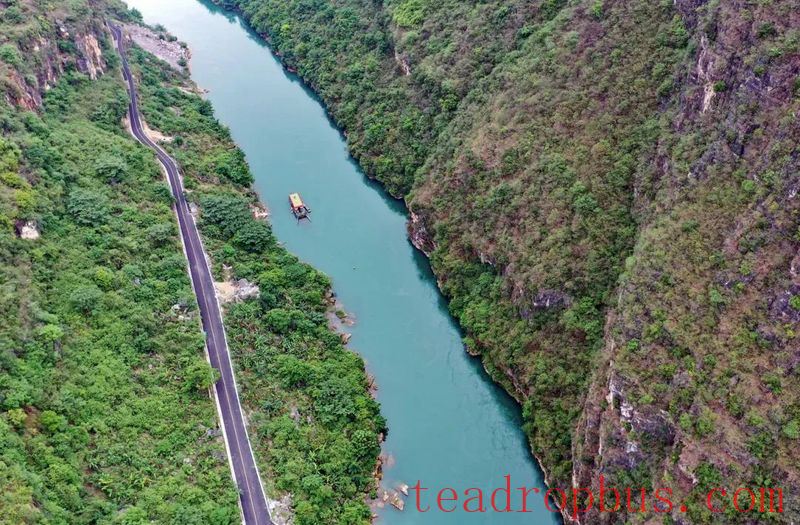
Landscape of Little Huajiang Canyon Source: Qianxinan Daily Newspaper Image Library
“Yao Ma Ge, Yao Ma Lang, carrying salt above and Sugar below.” As a must-pass place for travelers heading from Guizhou to Yunnan, the narrow stretch of clear water of Pingjie Township's Huajiang Village flows through steep cliffs, making it a crucial resting spot for horse caravans since ancient times.
The sound of horse bells and the flow of people were constant, leading to the establishment of inns and restaurants in Pingjie Township, which thrived due to commercial activity.
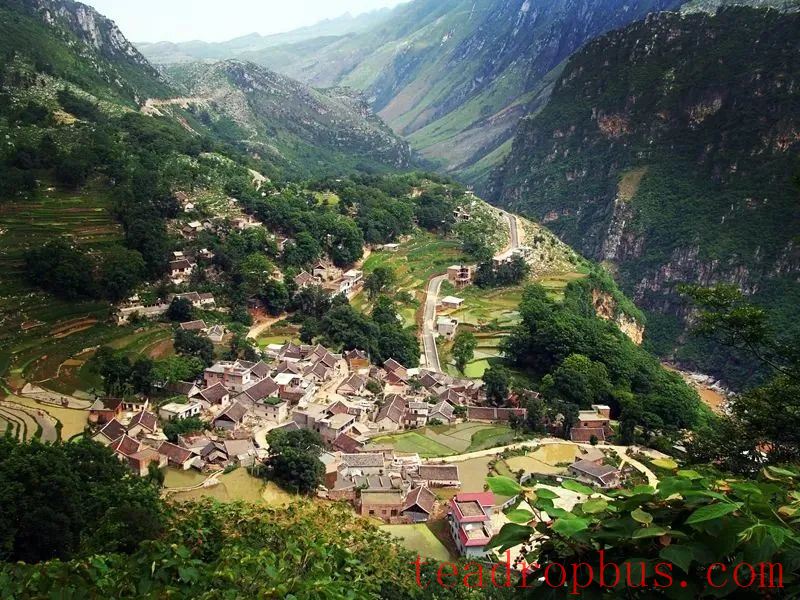
Photo by Liu Wei of Huajiang Village
The rugged and narrow ancient Tea-Horse Road, starting in Yingpan Village and ending at the Huajiang Iron Chain Bridge in Huajiang Village, spans approximately 16 kilometers. This ancient route, paved with wisdom and sweat, served as a corridor for ethnic economic and cultural exchange. Hoof prints are still visible on the cobblestone path, “recording” the prosperity of that era and reminding future generations of the hardships endured in the past.
In 2013, the Ancient Tea-Horse Road was listed as a national key cultural relic protection site of the seventh batch, with the Pingjie Township section being one of 40 such sites in Guizhou Province.
02
The Iron Chain Bridge Connects Past and Present
The Huajiang Iron Chain Bridge hangs between two mountains, measuring 71 meters long and 2.9 meters wide. Composed of 14 iron chains and 3,668 steel rings, it stands about 70 meters above the water, resembling a rainbow hanging over the river.
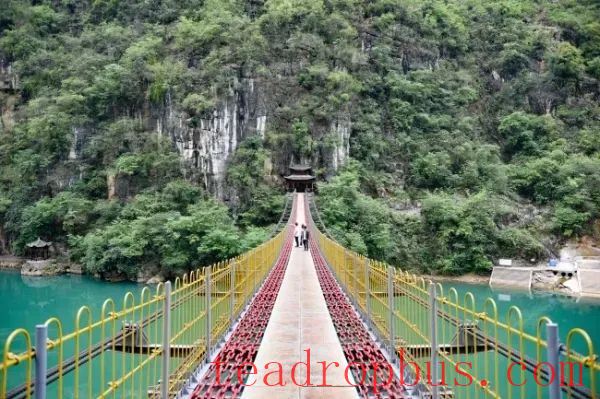
The Reconstructed Huajiang Iron Chain Bridge Photo by Gui Song
Historical inscriptions on the shore attest to its importance as a key transportation hub between Guizhou and Yunnan. On the southern bank are rock engravings reading “Iron Bridge Across the Han (River)” and “Flying Over the Beipan River”; on the northern bank are stone statues of Guanyin, the Earth God temple, the statue of Governor Zhu, the statue of Li Tieguai, and numerous poems and inscriptions from the Ming and Qing dynasties. As one of the few remaining ancient iron chain bridges in China, it holds significant historical, artistic, and research value.
In 1935, the vanguard forces of the First Red Army crossed the Beipan River. To protect the safe withdrawal of the central Red Army column, the Third Red Army stationed troops here to defend against enemies from the line between Guanling and Anshun. In April, Political Commissar Zhang Aiping of the Eleventh Regiment of the Third Red Army led his troops to guard the Huajiang Iron Chain Bridge, covering the Red Army's passage through Zhenfeng County, after which he wrote “Urgent Military Order – Rushing Across the Beipan River”: “The roar of the Beipan River shakes mountains and rivers, the enemy's shore steeply rises into the clouds. The main force moves eastward to seize the strategic point, deploying surprise troops, striking like lightning to occupy Bai Chen. Conquering Zhenfeng and descending upon Xingren, sweeping away leaves in the wind without stopping. Troops guarding Guanling, holding the rear, their schemes fail utterly.” This poem records the scene of the Red Army passing through Zhenfeng.
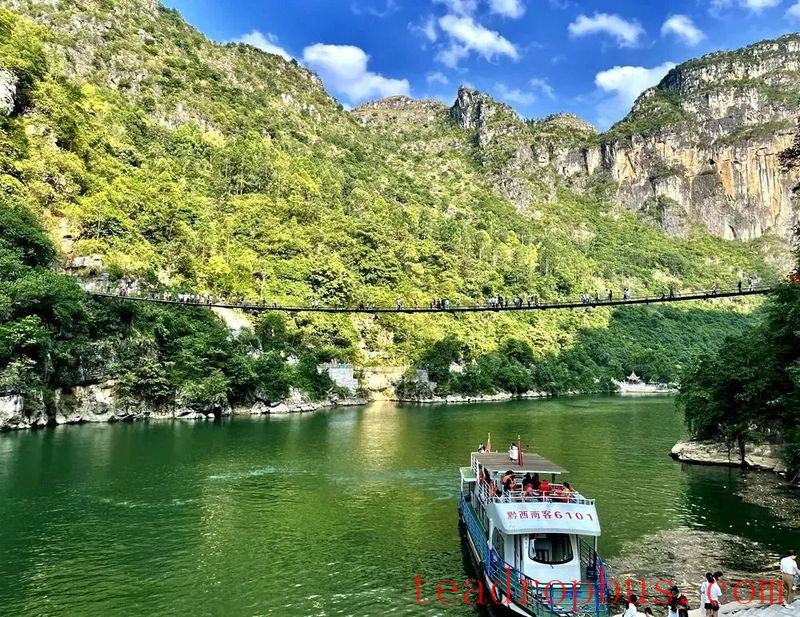
Zhenfeng's Huajiang Iron Chain Bridge Photo by Wang Guohua
In recent years, Zhenfeng County has implemented projects focusing on a red culture corridor, the Huajiang Iron Chain Bridge Red Army Battle Site Exhibition Hall, and a red culture teaching and research training base, among others, to build the Huajiang Iron Chain Bridge Red Army Long March Battle Site Park. Among these, the Little Huajiang scenic area, centered around the Zhenfeng Huajiang Iron Chain Bridge Red Army Long March Battle Site Park, was rated as a national AAA-level scenic area in 2025.
Currently, the Huajiang Iron Chain Bridge remains a vital transportation link across the canyon, providing convenience for residents in both Guanling and Zhenfeng. Relying on tourism, Huajiang Village has developed one educational base, three new farmhouses, and 18 guesthouses. More economic activities and projects will be launched in the future, and the economic and cultural values of the “Ancient Tea-Horse Road” and the “red” Iron Chain Bridge continue to expand.
03
A New Card for Bridge-Tourism Integration
The once impassable cliffs that hindered development now see the Huajiang Canyon Bridge spanning them.
When it comes to world bridges, look to China; when it comes to Chinese bridges, look to Guizhou. Spanning the Beipan River between Wuli Village in Huajiang Town, Guanling Autonomous County, and Huajiang Village in Pingjie Township, Zhenfeng County, the Huajiang Canyon Bridge is a key control project of the Liuzhi to Anlong Expressway.
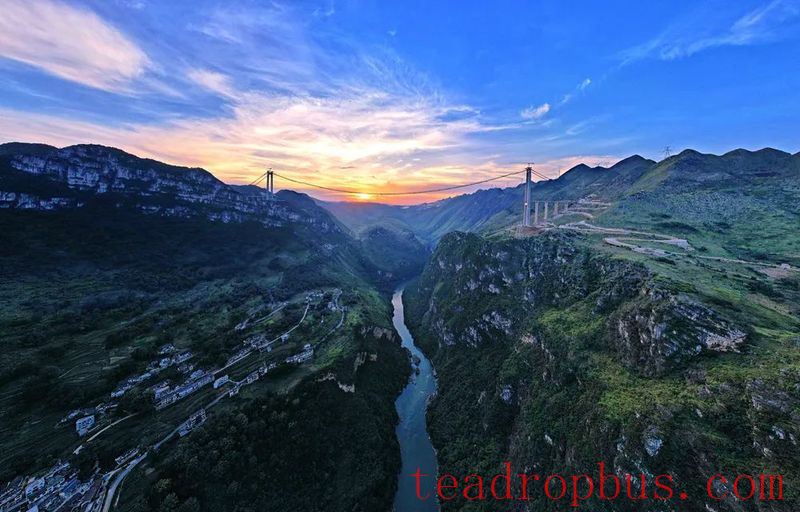
The Construction of the Huajiang Canyon Bridge Photo by Deng Peng
The bridge is 2,890 meters long, with a main span of 1,420 meters, and its deck is 625 meters vertically above the water level. Upon completion, it will surpass the North Beipan River Bridge on the Hangrui Expressway to become the new world's highest bridge.
As a key project for bridge-tourism integration during the “14th Five-Year Plan” period in Guizhou Province, the Huajiang Canyon Bridge is the first comprehensive facility in Guizhou that combines bridge sightseeing and aerial adventures. It is also a distinctive feature of the ongoing development of “the first tourism gateway in southwestern Guizhou, a new model for bridge-tourism integration in China, and a world-class destination for extreme sports in canyons.”
Bridges are not just transportation hubs but also drivers of economic development. Zhenfeng County integrates the unique romance and entrepreneurial spirit of Huajiang Village, further leveraging the bridge to combine educational tours, sports, museums, aerial dining, extreme sports, and other elements, continuously expanding the pathways for the integrated development of health, sports, and tourism. A bridge is more than just a bridge.